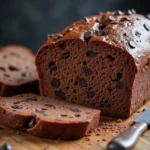Chocolate sourdough bread is a delightful twist on the traditional sourdough loaf. This bread brings together the tanginess of sourdough with the sweetness of rich, melt-in-your-mouth chocolate. Whether you’re an experienced baker or just starting your baking journey, making chocolate sourdough bread is a rewarding experience that will leave you with a delicious, aromatic loaf that can be enjoyed any time of day.
In this post, we’ll explore the basics of chocolate sourdough bread, from its origins to the key ingredients, and offer you a step-by-step guide to baking the perfect loaf. We’ll also look at some variations and tips for making this recipe your own.
What Is Chocolate Sourdough Bread?
Chocolate sourdough bread is a unique, flavorful variation of the classic sourdough bread. At its core, it uses the same basic technique as sourdough bread, where a natural fermentation process occurs using wild yeast from a sourdough starter. The key difference here is the addition of chocolate, which gives the bread a rich, sweet flavor with a tangy undertone.
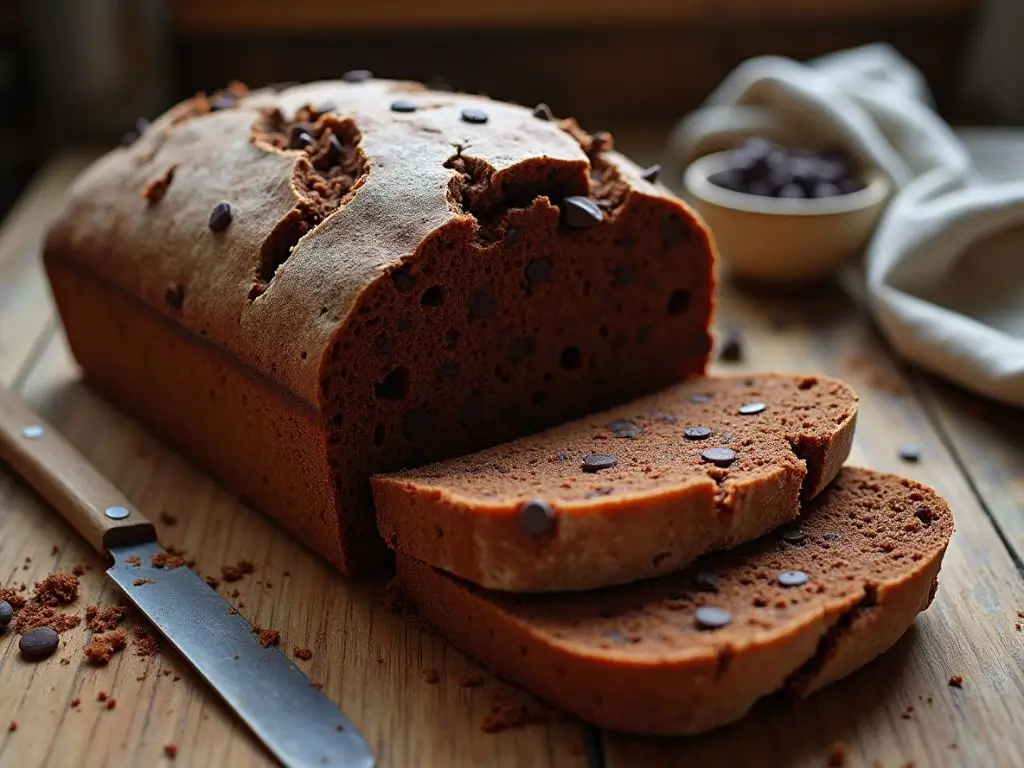
How Does It Differ from Traditional Sourdough?
Traditional sourdough bread is known for its tangy, slightly acidic taste due to the natural fermentation process. This tang comes from the lactic acid bacteria in the sourdough starter, which feed on the sugars in the dough and release lactic acid. Chocolate sourdough bread retains this tang, but the chocolate balances out the acidity with its rich, slightly sweet taste. The result is a unique bread that combines the best of both worlds: the earthy flavor of sourdough and the decadent sweetness of chocolate.
The Role of Sourdough Starter
A healthy sourdough starter is essential for making chocolate sourdough bread. This starter, made from a mixture of flour and water, contains wild yeast and beneficial bacteria that ferment the dough and help it rise. The distinctive tangy flavor and chewy texture of this bread come from the sourdough starter. Without it, you wouldn’t have the same distinctive sourdough experience, even with the addition of chocolate.
The Key Ingredients for Perfect Chocolate Sourdough Bread
The beauty of chocolate sourdough bread lies in the simplicity of the ingredients. While the classic sourdough recipe uses just a few basic ingredients, the addition of chocolate elevates the flavor profile and gives it an indulgent twist.
Sourdough Starter
As mentioned earlier, the sourdough starter is the heart of the recipe. The starter can be made from scratch or bought from a bakery, but if you’re using your own starter, make sure it’s healthy and active. A good starter should be bubbly and have a slightly tangy aroma. If your starter isn’t ready, your bread may not rise properly, so it’s essential to give it time to ferment.
Types of Chocolate to Use
When it comes to chocolate sourdough bread, the type of chocolate you use can make a significant difference. You can use a variety of chocolate options:
- Dark chocolate: Offers a rich, intense flavor that pairs beautifully with the sourdough’s tanginess.
- Milk chocolate: If you prefer a sweeter, creamier bread, milk chocolate is a great option.
- Chocolate chips: For added texture and pockets of melty chocolate, use chocolate chips or chunks throughout the dough.
Bread Flour and Yeast
Bread flour is key to getting the right texture for your chocolate sourdough bread. It has a higher protein content than all-purpose flour, which helps develop the gluten structure needed for a chewy, airy loaf. If you’re looking for a more rustic bread, you can also experiment with whole wheat flour.
While sourdough relies on wild yeast from the starter, you may want to add a small amount of active dry yeast to help the bread rise more quickly, especially if you’re in a hurry.
Optional Ingredients
- Sugar or sweeteners: While chocolate adds sweetness to the dough, you can also add sugar or honey for an extra touch of sweetness.
- Salt: A pinch of salt will help balance out the flavors and enhance the overall taste of the bread.
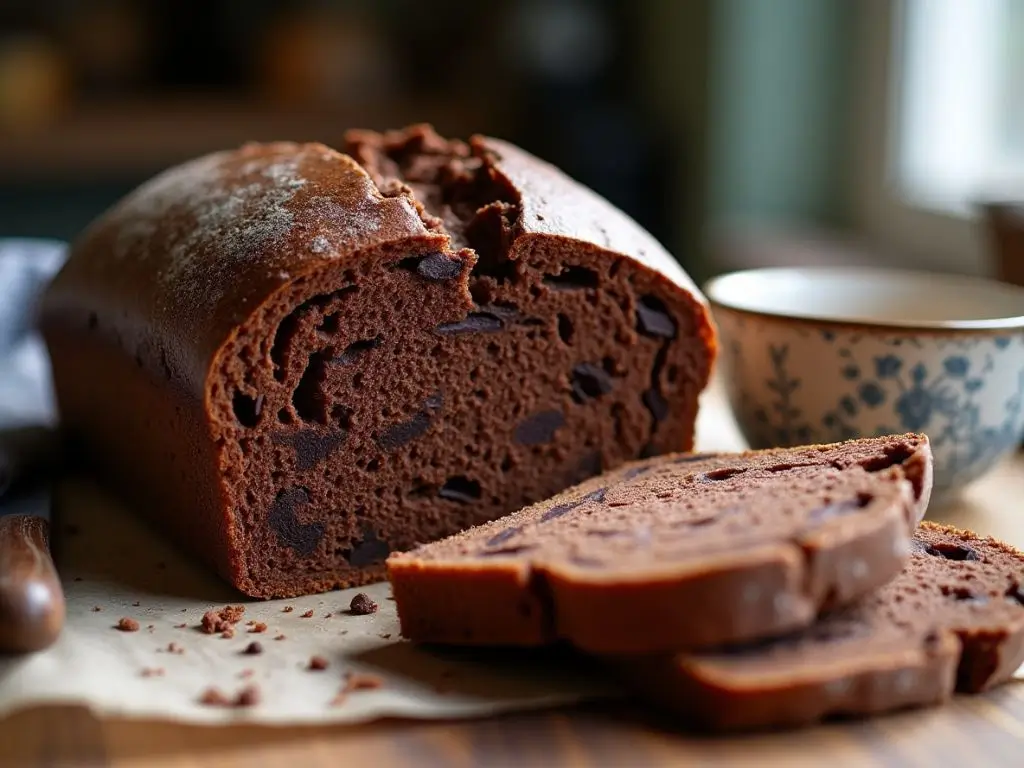
Step-by-Step Guide to Making Chocolate Sourdough Bread
Now that you understand the ingredients, let’s dive into the process of making chocolate sourdough bread. The method for chocolate sourdough bread is similar to regular sourdough, with a few key additions. Don’t be intimidated by the process—while sourdough bread requires patience, the results are worth it!
Step 1: Preparing the Sourdough Starter
If you’re starting with a homemade sourdough starter, ensure that it’s well-fed and active. You can feed your starter 8 to 12 hours before using it to ensure it’s bubbly and ready. If you’re using store-bought starter, simply follow the instructions on the package.
Step 2: Mixing the Ingredients
In a large bowl, combine your sourdough starter, flour, water, and any sweeteners you’re using. Mix until the dough comes together, and be sure to incorporate all of the flour. If the dough feels too sticky, simply incorporate a bit more flour to achieve the right consistency. Once mixed, let the dough rest for about 30 minutes to allow the flour to absorb the liquid.
Step 3: Kneading the Dough
Once the dough has rested, knead it by hand or in a stand mixer for about 10 minutes. You want the dough to be smooth, elastic, and slightly tacky. If you’re adding chocolate chips or chunks, incorporate them into the dough at this stage.
Step 4: First Rise (Bulk Fermentation)
Cover the dough and let it rise at room temperature for about 4-6 hours, or until it has doubled in size. This is the time when the wild yeast from the sourdough starter works its magic, causing the dough to ferment and rise.
Step 5: Shaping the Dough
After the dough has finished rising, gently place it onto a surface dusted with a little flour. Gently shape it into a round loaf or a batard (oval-shaped loaf). Be careful not to deflate the dough too much during this process, as you want to preserve the air bubbles created during fermentation.
Step 6: Second Rise (Proofing)
Place the shaped dough into a proofing basket or a bowl lined with a kitchen towel. Let the dough rise for another 2-4 hours, or until it has doubled in size again. For the best results, refrigerate the dough overnight to slow down the fermentation process and enhance the flavor.
Step 7: Baking the Bread
Preheat your oven to 450°F (230°C). Preheat a Dutch oven or baking stone by placing it inside. Once your oven is ready, carefully transfer the dough into the preheated pot or onto the baking stone. Cover it with a lid or another pot to trap steam and create a crusty exterior. Bake for 20 minutes, then remove the lid and bake for another 30-40 minutes, or until the bread is golden brown and sounds hollow when tapped on the bottom.
Step 8: Cooling
Let the chocolate sourdough bread cool on a wire rack before slicing. This will allow the flavor to develop and the texture to set properly.
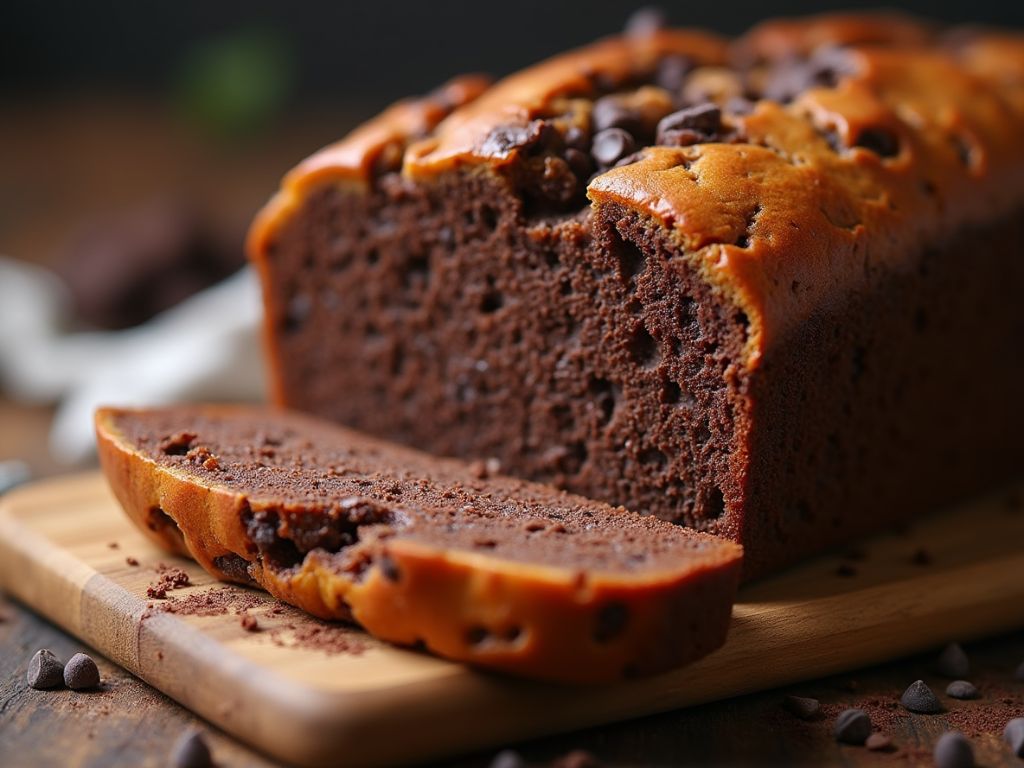
Nutrition Facts (per slice, 1/12 of the loaf):
| Nutrient | Amount |
|---|---|
| Calories | 220 kcal |
| Protein | 4g |
| Carbohydrates | 40g |
| Fiber | 2g |
| Sugars | 12g |
| Fat | 6g |
| Saturated Fat | 3g |
| Cholesterol | 10mg |
| Sodium | 150mg |
| Potassium | 200mg |
| Calcium | 20mg |
| Iron | 1mg |
Note: These values are approximate and will vary depending on the specific ingredients and serving size.
Tools You’ll Need for Making Chocolate Sourdough Bread:
- Mixing Bowls: For combining ingredients and mixing the dough.
- Dough Scraper: Helpful for handling sticky dough and dividing it.
- Stand Mixer (optional): Useful for kneading the dough quickly and efficiently.
- Proofing Basket or Bowl: To shape and proof the dough before baking.
- Dutch Oven or Baking Stone: Essential for creating a crisp, golden-brown crust.
- Parchment Paper: For transferring the dough into the Dutch oven or onto the baking stone.
- Measuring Cups and Spoons: To ensure you get the right amounts of flour, sugar, and other ingredients.
- Thermometer (optional): To check the internal temperature of the bread for perfect doneness (about 200°F/93°C).
- Wire Rack: For cooling the bread after baking.
- Bench Knife: For dividing and shaping the dough.
These tools will ensure that your chocolate sourdough bread turns out perfectly every time!
H2: The Benefits of Chocolate Sourdough Bread
Chocolate sourdough bread isn’t just a tasty treat; it also offers a variety of benefits that make it an appealing choice for your baking repertoire.
A Delicious Balance of Flavors
The tangy flavor of sourdough combined with the sweet richness of chocolate creates a complex and satisfying taste. Whether you enjoy it toasted with butter or as an afternoon snack, chocolate sourdough bread offers the perfect balance of flavors.
Health Benefits of Sourdough
Sourdough bread is often considered healthier than other types of bread due to its fermentation process. The natural fermentation of the dough helps break down phytic acid, which can interfere with the absorption of minerals like iron and zinc. The wild yeast also makes the bread easier to digest, which can be beneficial for people with sensitive stomachs.
Versatility in Serving
There are countless ways to savor chocolate sourdough bread. It’s perfect for breakfast, served with butter and jam, or for dessert, paired with whipped cream or a scoop of ice cream. You can even use it to make decadent French toast or a bread pudding.
Variations and Tips for Experimenting with Chocolate Sourdough Bread
While the classic chocolate sourdough bread recipe is already a delicious treat, there are countless ways to personalize it, whether you want to adjust the flavor, texture, or even dietary needs. Below are some fun variations and helpful tips that will allow you to experiment and make this bread your own!
Add Nuts or Dried Fruits
For an extra burst of flavor and texture, consider adding a variety of nuts or dried fruits to your chocolate sourdough bread. These ingredients pair beautifully with the rich chocolate and tangy sourdough.
- Nuts: Chopped nuts like walnuts, hazelnuts, or almonds bring a delightful crunch and complementary nutty flavor to the bread. The slightly bitter taste of nuts contrasts nicely with the sweet chocolate, creating a more complex flavor profile.
- Dried Fruits: Dried cherries, raisins, cranberries, or apricots are perfect additions to chocolate sourdough bread. Their natural sweetness and chewy texture enhance the overall flavor and add a pop of color to the dough. Dried fruits also provide extra moisture, which helps keep the bread soft and tender.
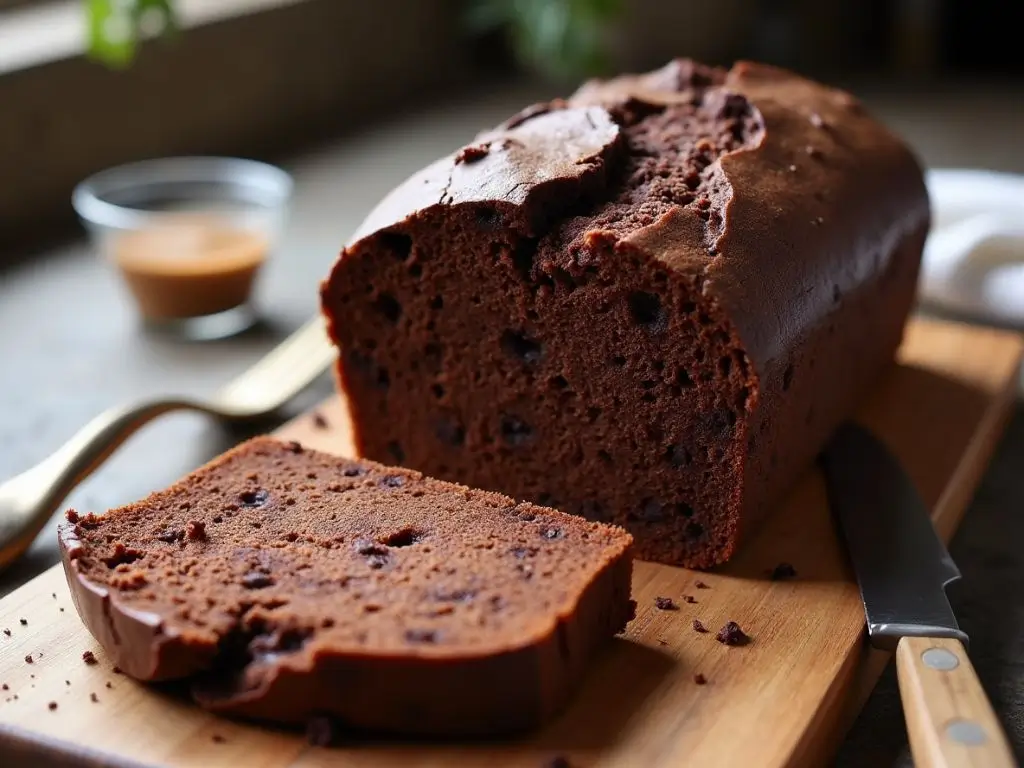
Tip: If you’re adding nuts or dried fruits, be sure to fold them into the dough gently after the first rise to avoid overworking the dough.
Make It Gluten-Free
If you’re following a gluten-free diet or have gluten sensitivities, you can still enjoy chocolate sourdough bread by making a few substitutions. While gluten-free bread can be tricky, using the right blend of gluten-free flours can help achieve the desired texture.
- Flour Substitutes: Use a gluten-free flour blend that includes a combination of rice flour, potato starch, and tapioca flour for the best results. Many gluten-free flour blends also contain xanthan gum, which helps mimic the elasticity of gluten in traditional sourdough bread.
- Sourdough Starter: If you’re making a gluten-free chocolate sourdough bread, you’ll need a gluten-free sourdough starter as well. You can create this starter using a gluten-free flour like brown rice flour or sorghum flour, combined with water and wild yeast, just as you would with regular flour.
Tip: Gluten-free sourdough bread may not rise as much as regular sourdough, so be prepared for a denser loaf. Additionally, the bread may have a slightly different texture, but it will still be delicious and worth experimenting with.
Adjust the Sweetness Level
One of the best things about baking your own chocolate sourdough bread is that you have full control over the sweetness. If you want a sweeter loaf, consider adjusting the type and quantity of sweeteners you use.
- Chocolate Type: Dark chocolate provides a more intense, bittersweet flavor, while milk chocolate creates a sweeter, creamier bread. You can even use white chocolate for a different taste profile that still pairs well with the tang of sourdough.
- Sugar and Sweeteners: You can enhance the sweetness of the bread by adding a touch of brown sugar or honey to the dough. Brown sugar adds a deeper, molasses-like flavor, while honey provides a subtle sweetness with floral notes. If you prefer a lower-sugar version, you can use alternatives like maple syrup or agave nectar.
Tip: Start with a small amount of added sugar and taste the dough. You can always add more, but it’s harder to reduce the sweetness once it’s incorporated.
Make It Vegan
For those following a vegan lifestyle, it’s easy to adapt this recipe to suit your needs. The key is to replace animal-based ingredients like butter, milk, and eggs with plant-based alternatives.
- Butter Substitute: Use a dairy-free butter or olive oil in place of regular butter. Coconut oil also works well for adding moisture and a subtle tropical flavor.
- Milk Substitute: Replace any dairy milk with a plant-based milk such as almond milk, oat milk, or coconut milk. These alternatives will provide the same consistency and texture without compromising flavor.
- Egg Substitute: If your recipe calls for eggs, you can use an egg replacement like flaxseed meal mixed with water (1 tablespoon flaxseed meal + 3 tablespoons water = 1 egg). Other alternatives include chia seeds, applesauce, or silken tofu for binding.
Tip: While making your chocolate sourdough bread vegan, keep an eye on the dough consistency. Vegan dough may behave slightly differently, so it’s important to adjust the liquid levels as needed.
Experiment with Different Types of Chocolate
Chocolate sourdough bread is versatile, and you can play around with different types of chocolate to create new flavor combinations. Here are a few ideas:
- Milk Chocolate: If you prefer a sweeter, milder flavor, opt for milk chocolate. It’s perfect for anyone with a sweet tooth or those who enjoy a more subtle chocolate flavor.
- Bittersweet or Semi-Sweet Chocolate: For a deeper chocolate flavor that’s not overly sweet, bittersweet or semi-sweet chocolate is an excellent option. These types of chocolate will give your bread a sophisticated richness and complexity.
- White Chocolate: If you’re looking for a unique twist, consider using white chocolate. Although it’s not technically chocolate (since it doesn’t contain cocoa solids), it still provides a creamy sweetness that pairs well with sourdough’s tanginess.
- Chocolate and Coffee: Chocolate and coffee are a match made in heaven! You can add a tablespoon of instant coffee or espresso powder to the dough to amplify the chocolate flavor and add an extra depth of taste.
Tip: Chop the chocolate into small chunks to ensure even distribution throughout the dough. If you’re using chocolate chips, consider folding them into the dough gently to avoid them melting too much during the baking process.
Conclusion
Chocolate sourdough bread is an indulgent yet simple way to elevate your baking skills. The rich flavor of chocolate complements the tanginess of sourdough, creating a loaf that’s perfect for any occasion. Whether you’re an experienced baker or just starting out, this recipe is sure to impress. Experiment with different variations and enjoy the many ways to savor your creation
Try out this Chocolate sourdough bread and let your creativity shine! We’d love to see your sweet creations. Tag us on Instagram at @SweetEatsRecipes and use the hashtag #Chocolatesourdoughbread to get featured.
Chocolate Sourdough Bread
Ingredients
- 1 cup active sourdough starter
- 1 cup warm water
- 2 1/2 cups all-purpose flour
- 1/4 cup cocoa powder
- 1/2 cup dark chocolate chips
- 1/4 cup sugar (adjust to taste)
- 1/4 cup unsalted butter, softened
- 1 tsp vanilla extract
- 1/2 tsp salt
Instructions
- Mix the Dough: In a large mixing bowl, combine the sourdough starter, warm water, and sugar. Gradually add the flour, cocoa powder, and salt, and mix until the dough comes together.
- Knead the Dough: Transfer the dough to a floured surface and knead for about 10 minutes until it’s smooth and elastic.
- First Rise: Place the dough in a lightly greased bowl, cover, and let it rise for 3-4 hours until doubled in size.
- Shape the Dough: After the dough has risen, turn it out onto a floured surface, gently deflate, and shape into a loaf.
- Second Rise: Place the shaped dough in a proofing basket or bowl, cover, and let it rise for another 1-2 hours.
- Bake: Preheat your oven to 450°F (230°C). Bake the bread for 45 minutes or until the internal temperature reaches 200°F (93°C).
- Cool: Allow the bread to cool on a wire rack before slicing.


